Assessment of Groundwater Resources in Coastal Areas of Pakistan for Sustainable Water Quality Management Using Joint Geophysical and Geochemical Approach: A Case Study
Abstract
:1. Introduction
2. Study Area and Hydrogeological Setting
3. Materials and Methods
3.1. Dar-Zarrouk Parameters
3.2. Physicochemical Method
4. Results
4.1. Interpretation of VES Models
4.2. Analysis of Dar-Zarrouk Parameters
4.2.1. Longitudinal Conductance
4.2.2. Transverse Resistance
4.2.3. Longitudinal Resistivity
4.2.4. Analysis of Physicochemical Parameters
5. Discussion
6. Conclusions
Author Contributions
Funding
Acknowledgments
Conflicts of Interest
References
- Barlow, P.M.; Reichard, E.G. Saltwater intrusion in coastal regions of North America. Hydrogeol. J. 2010, 18, 247–260. [Google Scholar] [CrossRef]
- Gopalakrishnan, T.; Hasan, M.K.; Haque, A.; Jayasinghe, S.L.; Kumar, L. Sustainability of coastal agriculture under climate change. Sustainability 2019, 11, 7200. [Google Scholar] [CrossRef] [Green Version]
- Cardona, A.; Carrillo-Rivera, J.J.; Huizar-A’lvarez, R.; Graniel-castro, E. Salinization in coastal aquifers of arid zones: An example from Santo Domingo, Baja California Sur, Mexico. Environ. Geol. 2004, 45, 350–366. [Google Scholar] [CrossRef]
- Hasan, M.; Shang, Y.; Akhter, G.; Jin, W.J. Delineation of contaminated aquifers using integrated geophysical methods in Northeast Punjab, Pakistan. Environ. Monit. Assess. 2019, 192, 12. [Google Scholar] [CrossRef]
- Hasan, M.; Shang, Y.; Akhter, G.; Jin, W. Delineation of saline-water intrusion using surface geoelectrical method in Jahanian Area, Pakistan. Water 2018, 10, 1548. [Google Scholar] [CrossRef] [Green Version]
- Gopalakrishnan, T.; Kumar, L.; Mikunthan, T. Assessment of spatial and temporal trend of groundwater salinity in Jaffna Peninsula and its link to paddy land abandonment. Sustainability 2020, 12, 3681. [Google Scholar] [CrossRef]
- Mas-Pla, J.; Ghiglieri, G.; Uras, G. Seawater intrusion and coastal groundwater resources management. Examples from two mediterranean regions: Catalonia and Sardinia. Contrib. Sci. 2014, 10, 171–184. [Google Scholar]
- Shi, L.; Jiao, J.J. Seawater intrusion and coastal aquifer management in China: A review. Environ. Earth Sci. 2014, 72, 2811–2819. [Google Scholar] [CrossRef]
- Morgan, L.K.; Werner, A.D. A national inventory of seawater intrusion vulnerability for Australia. J. Hydrol. Reg. Stud. 2015, 4, 686–698. [Google Scholar] [CrossRef] [Green Version]
- Chen, D.; Elhadj, A.; Xu, H.; Xu, X.; Qiao, Z. A Study on the Relationship between land use change and water quality of the mitidja watershed in Algeria based on GIS and RS. Sustainability 2020, 12, 3510. [Google Scholar] [CrossRef]
- Bear, J. Conceptual and mathematical modeling. In Seawater Intrusion in Coastal Aquifers; Springer: Dordrecht, The Netherlands, 1999; pp. 127–161. [Google Scholar]
- Hasan, M.; Shang, Y.; Akhter, G.; Jin, W. Application of VES and ERT for delineation of fresh-saline interface in alluvial aquifers of Lower Bari Doab, Pakistan. J. Appl. Geophys. 2019, 164, 200–213. [Google Scholar] [CrossRef]
- Jalali, M. Salinization of groundwater in arid and semi-arid zones: An example from Tajarak, western Iran. Environ. Geol. 2007, 52, 1133–1149. [Google Scholar] [CrossRef]
- Adepelumi, A.A.; Ako, B.D.; Ajayi, T.R.; Afolabi, O.; Omotoso, E.J. Delineation of saltwater intrusion into the freshwater aquifer of Lekki Peninsula, Lagos, Nigeria. Environ. Geol. 2009, 56, 927–933. [Google Scholar] [CrossRef]
- Carol, E.; Kruse, E.; Mas-Pla, J. Hydrochemical and isotopical evidence of ground water salinization processes on the coastal plain of Samborombón Bay, Argentina. J. Hydrol. 2009, 365, 335–345. [Google Scholar] [CrossRef]
- Shammas, M.I.; Jacks, G. Seawater intrusion in the Salalah plain aquifer, Oman. Environ. Geol. 2007, 53, 575–587. [Google Scholar] [CrossRef]
- Khublaryan, M.G.; Frolov, A.P.; Yushmanov, I.O. Seawater intrusion into coastal aquifers. Water Resour. 2008, 35, 274–286. [Google Scholar] [CrossRef]
- Essink, G.H.P.O. Improving fresh groundwater supply-problems and solutions. Ocean Coast. Manag. 2001, 44, 429–449. [Google Scholar] [CrossRef]
- Werner, A.D.; Bakker, M.; Post, V.E.A.; Vandenbohede, A.; Lu, C.; Ataie-Ashtiani, B.; Simmons, C.T.; Barry, D.A. Seawater intrusion processes, investigation and management: Recent advances and future challenges. Adv. Water. Resour. 2013, 51, 3–26. [Google Scholar] [CrossRef]
- Zhu, S.; Zhou, Z.; Guo, Q.; Ma, J. A Study on the cause of layered seawater intrusion in the daqing river estuary of Liaodong Bay, China. Sustainability 2020, 12, 2842. [Google Scholar] [CrossRef] [Green Version]
- Ros, S.E.M.; Zuurbier, K.G. The impact of integrated aquifer storage and recovery and Brackish Water Reverse Osmosis (ASRRO) on a coastal groundwater system. Water 2017, 9, 273. [Google Scholar] [CrossRef]
- Leghouchi, E.; Laib, E.; Guerbet, M. Evaluation of chromium contamination in water, sediment and vegetation caused by the tannery of Jijel (Algeria): A case study. Environ. Monit. Assess. 2009, 153, 111–117. [Google Scholar] [CrossRef] [PubMed]
- Ebraheem, A.A.M.; Senosy, M.M.; Dahab, K.A. Geoelectrical and hydrogeochemical studies for delineating groundwater contamination due to salt-water intrusion in the northern part of the Nile delta, Egypt. Ground Water 1997, 35, 216–222. [Google Scholar] [CrossRef]
- Hopkins, D.G.; Richardson, J.L. Detecting a salinity plume in an unconfined sandy aquifer and assessing secondary soil salinization using electromagnetic induction techniques, North Dakota, USA. Hydrogeol. J. 1999, 7, 380–392. [Google Scholar] [CrossRef]
- Edet, A.E.; Okereke, C.S. A regional study of saltwater intrusion in southeastern Nigeria based on the analysis of geoelectrical and hydrochemical data. Environ. Geol. 2001, 40, 1278–1289. [Google Scholar]
- Lee, S.; Kim, K.; Ko, I.; Hwang, H. Geochemical and geophysical monitoring of saline water intrusion in Korean paddy fields. Environ. Geochem. Health 2002, 24, 277–291. [Google Scholar] [CrossRef]
- Wilson, S.R.; Ingham, M.; McConchie, J.A. The applicability of earth resistivity methods for saline interface definition. J. Hydrol. 2006, 316, 301–312. [Google Scholar] [CrossRef]
- Bataynch, A.T. Use of electrical resistivity methods for detecting subsurface fresh and saline water and delineating their interfacial configuration: A case study of the eastern Dead Sea coastal aquifers, Jordan. Hydrogeol. J. 2006, 14, 1277–1283. [Google Scholar] [CrossRef]
- Sherif, M.; El Mahmoudi, A.; Graamoon, H.; Kacimov, A.; Akram, S.; Ebraheem, A.; Shetty, A. Geoelectrical and hydrogeochemical studies for delineating seawater intrusion in the outlet of Wadi Ham, UAE. Environ. Geol. 2006, 49, 536–551. [Google Scholar] [CrossRef]
- Hasan, M.; Shang, Y.; Akhter, G.; Khan, M. Geophysical Investigation of Fresh-Saline Water Interface: A Case Study from South Punjab, Pakistan. Groundwater 2017, 55, 841–856. [Google Scholar] [CrossRef]
- Loke, M.H.; Acworth, I.; Dahlin, T. A comparison of smooth and blocky inversion method in 2D electrical tomography surveys. Explor. Geophys. 2003, 34, 182–187. [Google Scholar] [CrossRef]
- Singh, U.K.; Das, R.K.; Hodlur, G.K. Significance of Dar-Zarrouk parameters in the exploration of quality affected coastal aquifer systems. Environ. Geol. 2004, 45, 696–702. [Google Scholar] [CrossRef]
- Henriet, J.P. Direct application of the Dar-Zarrouk parameters in ground water surveys. Geophys. Prospect 1976, 24, 344–353. [Google Scholar] [CrossRef]
- Singh, K.P. Nonlinear estimation of aquifer parameters from surficial resistivity measurements. Hydrol. Earth Syst. Sci. Discuss. 2005, 2, 917–938. [Google Scholar] [CrossRef] [Green Version]
- Batayneh, A.T. The estimation and significance of Dar-Zarrouk parameters in the exploration of quality affecting the Gulf of Aqaba coastal aquifer systems. J. Coast. Conserv. 2013, 17, 623–635. [Google Scholar] [CrossRef]
- Nwankwo, C.; Nwosu, L.; Emujakporue, G. Determination of Dar Zarouk parameters for the assessment of groundwater resources potential: Case study of Imo State, south eastern Nigeria. J. Econ. Sustain. Dev. 2011, 2, 57–71. [Google Scholar]
- Yasala, S.; Olivera, H.; Raja, A.S.; Muthurajb, D.; Chandrasekara, N. Estimation of conductance anomalies in subsurface through Dar- Zarrouk parameters by resistivity inversion method. Int. J. Phys. Math. Sci. 2012, 3, 140–151. [Google Scholar]
- Zohdy, A.R. The auxiliary point method of electrical sounding interpretation, and its relationship to the Dar Zarrouk parameters. Geophysics 1965, 30, 644–660. [Google Scholar] [CrossRef]
- Agoubi, B.; Kharroubi, A.; Abichou, T.; Abida, H. Hydrochemical and geoelectrical investigation of Marine Jeffara aquifer, southeastern Tunisia. Appl. Water Sci. 2013, 3, 415–429. [Google Scholar] [CrossRef]
- Kouzana, L.; Benassi, R.; Ben Mammou, A.; Sfar Felfoul, M. Geophysical and hydrochemical study of the seawater intrusion in Mediterranean semiarid zones, case of the Korba coastal aquifer (Cap-Bon, Tunisia). J. Afr. Earth Sci. 2010, 58, 242–254. [Google Scholar] [CrossRef]
- Cimino, A.; Cosentino, C.; Oieni, A.; Tranchina, L. A Geophysical and geochemical approach for seawater intrusion assessment in the Acquedolci coastal aquifer (Northern Sicily). Environ. Geol. 2008, 55, 1473–1482. [Google Scholar] [CrossRef]
- Kazakis, N.; Pavlou, A.; Vargemezis, G.; Voudouris, K.S.; Soulios, G.; Pliakas, F.; Tsokas, G. Seawater intrusion mapping using electrical resistivity tomography and hydrochemical data. An application in the coastal area of eastern Thermaikos Gulf, Greece. Sci. Total Environ. 2016, 543, 373–387. [Google Scholar] [CrossRef] [PubMed]
- Fadili, A.; Najib, S.; Mehdi, K.; Riss, J.; Malaurent, P.; Makan, A. Geoelectrical and hydrochemical study for the assessment of seawater intrusion evolution in coastal aquifers of Oualidia, Morocco. J. Appl. Geophys. 2017, 146, 178–187. [Google Scholar] [CrossRef]
- Najib, S.; Fadili, A.; Mehdi, K.; Riss, J.; Makan, A. Contribution of hydrochemical and geoelectrical approaches to investigate salinization process and seawater intrusion in the coastal aquifers of Chaouia. Morocco. J. Contam. Hydrol. 2017, 198, 24–36. [Google Scholar] [CrossRef]
- Water and Power Development Authority, Pakistan (WAPDA). Annual Report of River and Climatological Data of Pakistan, River Discharge, Sediment and Quality Data; Prepared by Surface Water Hydrology Project; WAPDA: Lahore, Pakistan, 1973.
- Water and Power Development Authority, Pakistan (WAPDA). Annual Reports 1988–89; WAPDA: Lahore, Pakistan, 1989; pp. 21–98.
- George, N.J.; Ibanga, J.I.; Ubom, A.I. Geoelectrohydrogeological indices of evidence of ingress of saline water into freshwater in parts of coastal aquifers of Ikot Abasi, southern Nigeria. J. Afr. Earth Sci. 2015, 109, 37–46. [Google Scholar] [CrossRef]
- Samouëlian, A.; Cousin, I.; Tabbagh, A.; Bruand, A.; Richard, G. Electrical resistivity survey in soil science: A review. Soil Tillage Res. 2005, 83, 173–193. [Google Scholar] [CrossRef] [Green Version]
- Telford, W.M.; Geldart, L.P.; Sheriff, R.E. Applied Geophysics; Cambridge University Press: Cambridge, UK, 1990; p. 770. [Google Scholar]
- Zarroca, M.; Bach, J.; Linares, R.; Pellicer, X.M. Electrical methods (VES and ERT) for identifying, mapping and monitoring different saline domains in a coastal plain region (Alt Emporda, Northern Spain). J. Hydrol. 2011, 409, 407–422. [Google Scholar] [CrossRef]
- Stewart, M.T. Evaluation of electromagnetic methods for rapid mapping of salt-water interfaces in coastal waters. Ground Water 1982, 20, 538–545. [Google Scholar] [CrossRef]
- Fitterman, D.V.; Stewart, M.T. Transient electromagnetic sounding for groundwater. Geophysics 1986, 51, 995–1005. [Google Scholar] [CrossRef]
- Duque, C.; Calvache, M.L.; Pedrera, A.; Rosales, W.M.; Chicano, M.L. Combined time domain electromagnetic soundings and gravimetry to determine marine intrusion in a detrital coastal aquifer (Southern Spain). J. Hydrol. 2008, 348, 536–547. [Google Scholar] [CrossRef]
- Bakker, T.W.; Jungerius, P.D.; Klijn, J.A. Dunes of the European Coasts: Geohydrology, Hydrology, Soils. Catena Suppl 1990, 18, 109–119. [Google Scholar]
- Batte, A.G.; Muwanga, A.; Sigrist, W.P. Evaluating the Use of Vertical Electrical Sounding As A Groundwater Exploration Technique To Improve On The Certainty Of Borehole Yield In Kamuli District (Eastern Uganda). Afr. J. Sci. Technol. (AJST) Sci. Eng. Ser. 2008, 9, 72–85. [Google Scholar]
- IpI2Winv.2.1Usersguide. Computer Software User Guide Catalog; Moscow State University, Geological Faculty, Department of Geophysics and GEOSCAN-M Ltd: Moscow, Russia, 2001; p. 25.
- Todd, D.K.; Mays, L.W. Groundwater Hydrology; John Wiley & Sons: Hoboken, NJ, USA, 2004. [Google Scholar]
- Kelly, W.E.; Reiter, P.F. Influence of anisotropy on relation between electrical and hydraulic properties. J. Hydrol. 1984, 74, 311–321. [Google Scholar] [CrossRef]
- APHA (American Public Health Association). Standard Methods for the Examination of Water and Wastewater; American Public Health Association: Washington, DC, USA, 2000. [Google Scholar]
- WHO (World Health Organization). Guidelines for Drinking-Water Quality. Recommendations Incorporating 1ST and 2nd Addenda, 3rd ed.; World Health Organization: Geneva, Switzerland, 2008; Volume 1. [Google Scholar]
- Batayneh, A.T. Hydrogeophysical investigation of groundwater potential in the southern Amman District, central Jordan. Arab J. Sci. Eng. 2011, 36, 89–96. [Google Scholar] [CrossRef]
- Zhdanov, M.; Keller, G. The Geoelectrical Methods in Geophysical Exploration. In Methods in Geochemistry and Geophysics; Zhdanov, M., Wannamaker, P.E., Eds.; Elsevier: Amsterdam, The Netherlands, 1994; p. 408. [Google Scholar]

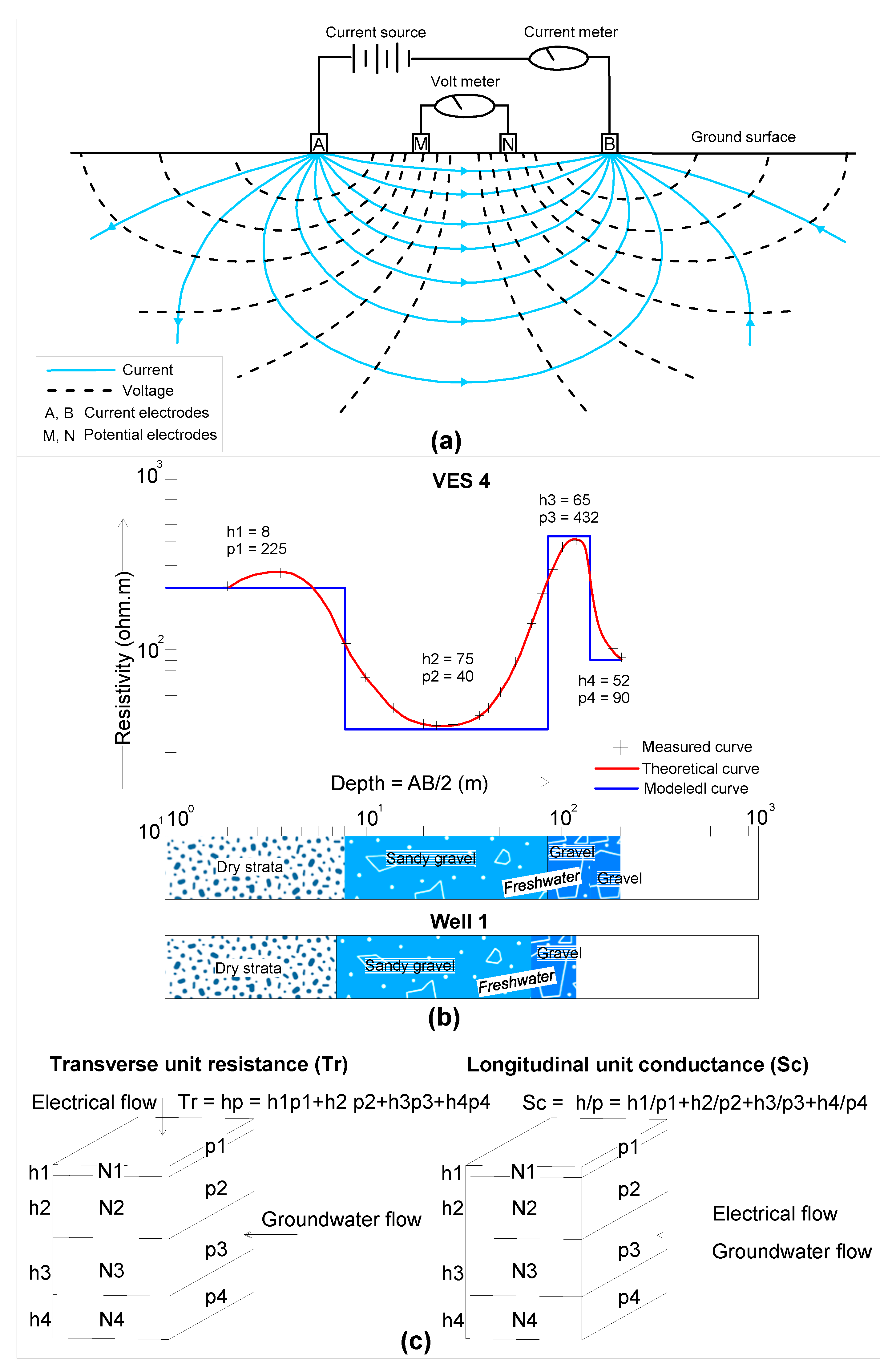
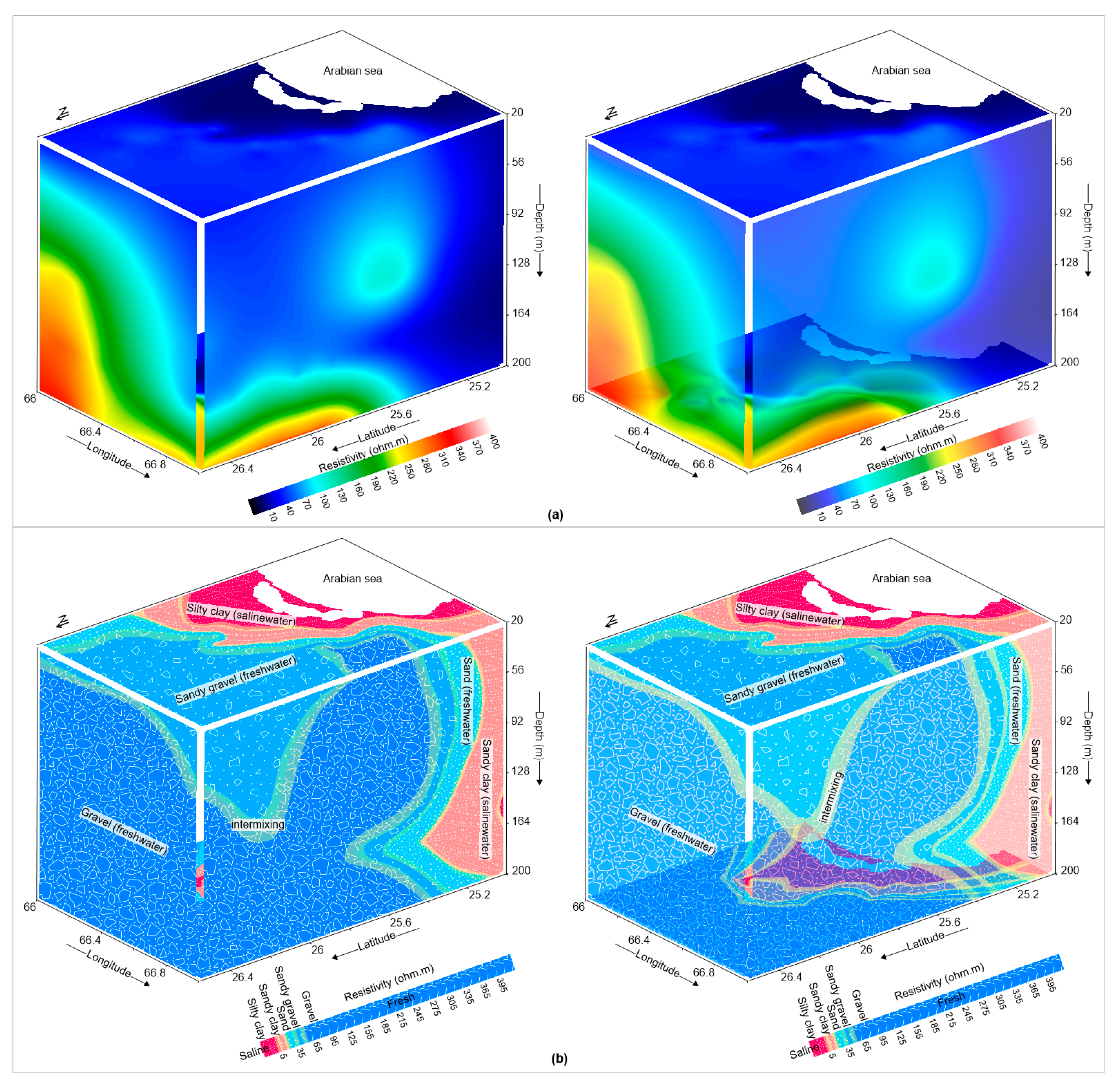
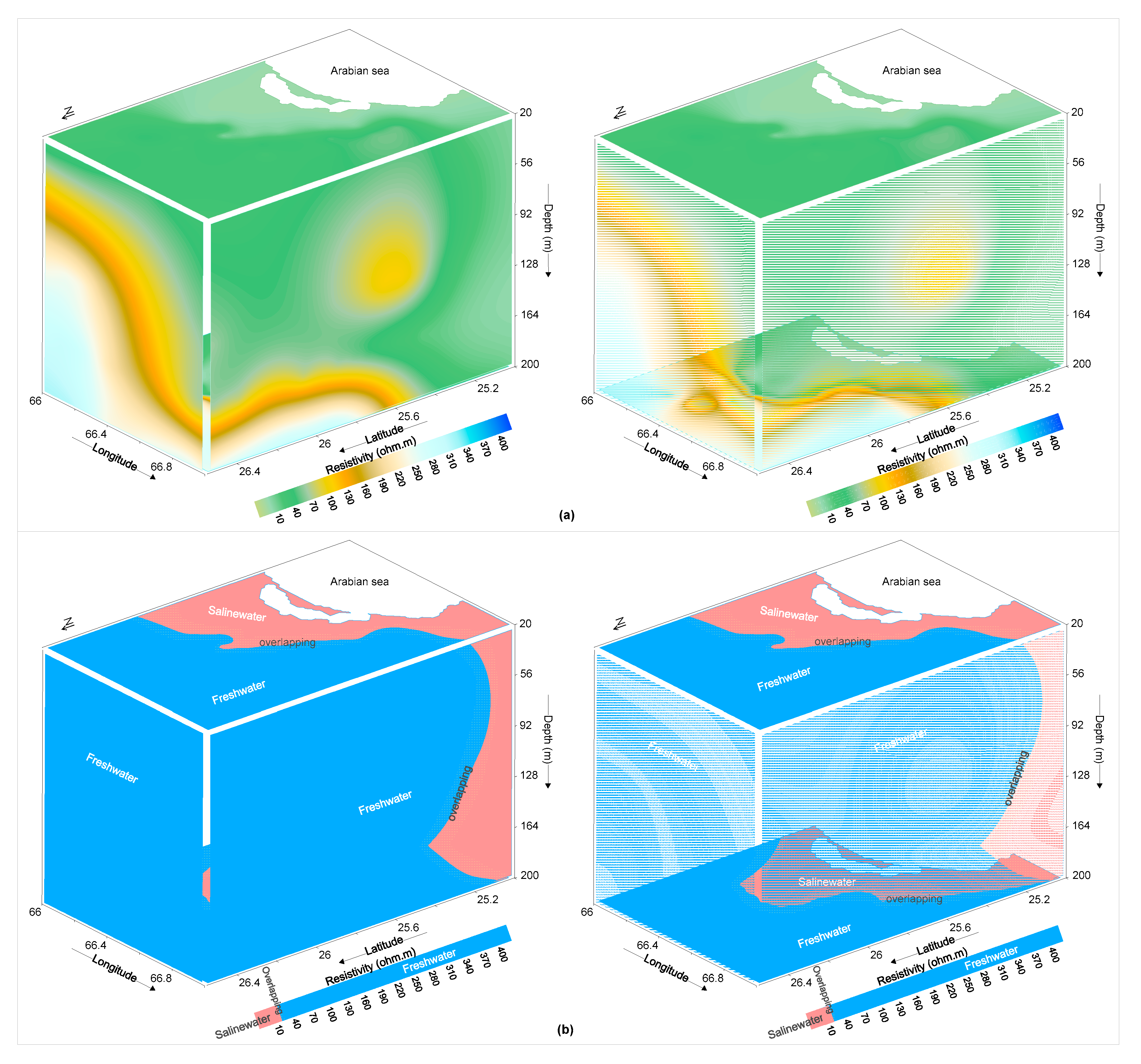
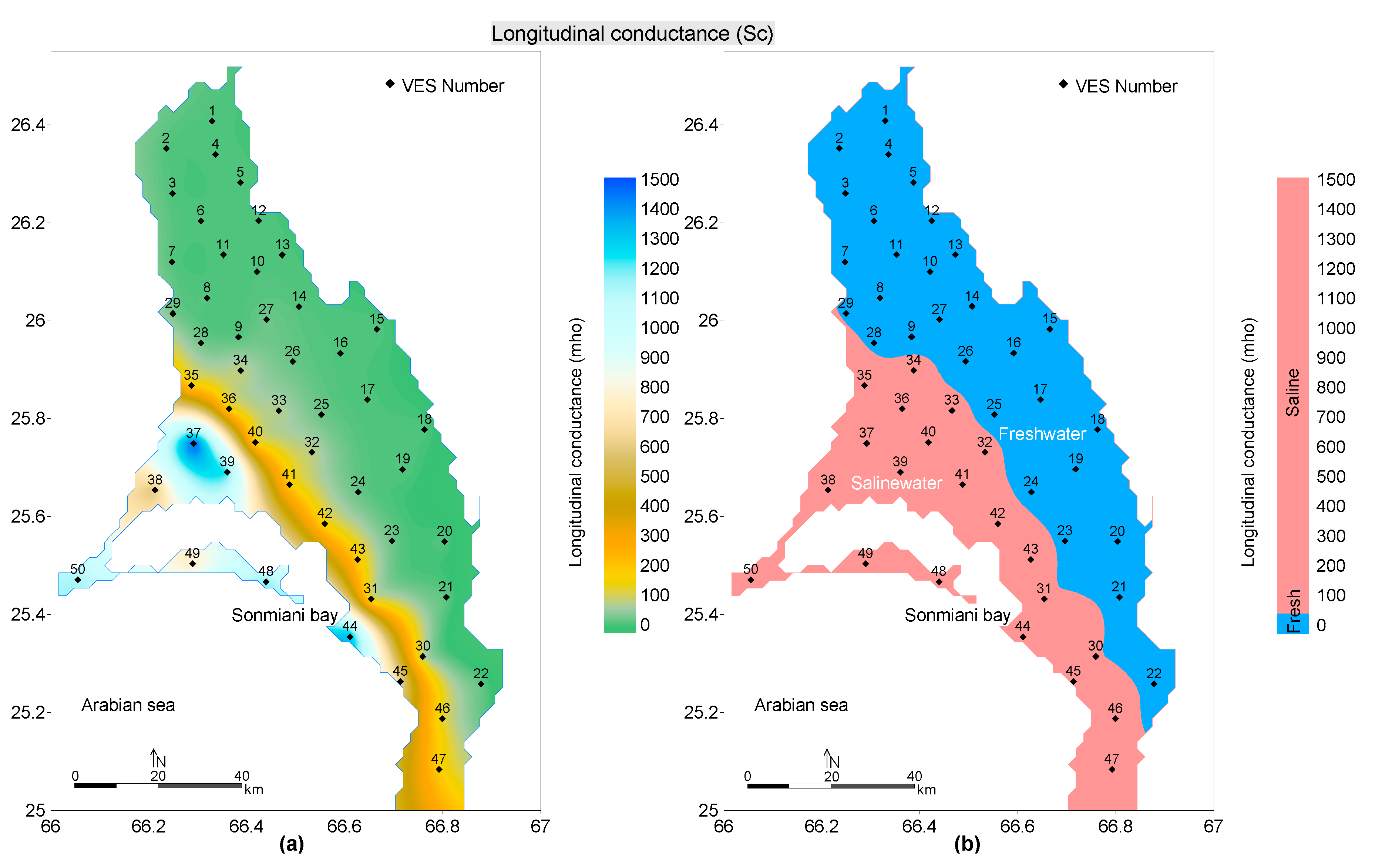



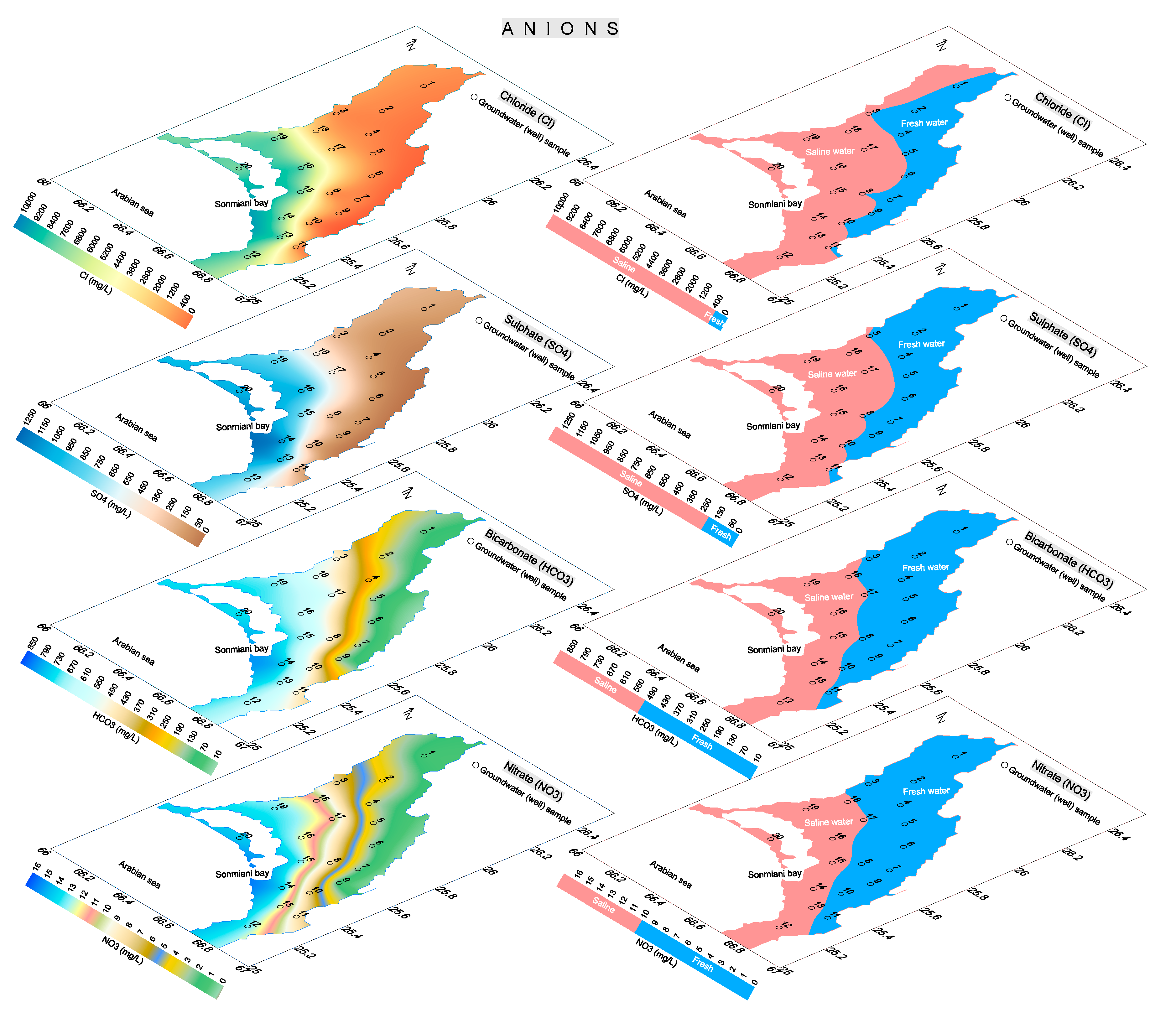

| Subsurface Resistivity (Ωm) | Water Table | Lithology Type | Water Type |
|---|---|---|---|
| >30 | Above | Topsoil cover | Dry strata |
| <10 | Below | Clay or silt | Saline water |
| 5–25 | Below | Sandy clay | Saline water |
| 20–40 | Below | Sand | Freshwater |
| 35–55 | Below | Sandy gravel | Freshwater |
| >50 | Below | Gravel | Freshwater |
| Dar-Zarrouk Parameters | Water Type | Obtained Range | Observed Range |
|---|---|---|---|
| Longitudinal unit conductance (SC) | Freshwater | <40 mho | 2–20.3 mho |
| Saline water | >40 mho | 59–1510 mho | |
| Transverse unit resistance (Tr) | Freshwater | >2500 Ωm2 | 3849–39,375 Ωm2 |
| Saline water | <2500 Ωm2 | 65–1711 Ωm2 | |
| Longitudinal resistivity (ρL) | Freshwater | >5 Ωm | 9.4–93.3 Ωm |
| Saline water | <5 Ωm | 0.1–3.2 Ωm |
| Physicochemical Parameters | Units | Minimum | Maximum | Mean | Median | S.D | Suggested Range of PSQCA/PCRWR for Aquifers | ||
|---|---|---|---|---|---|---|---|---|---|
| Fresh | Saline | ||||||||
| Cations | Na+ | (mg/L) | 28 | 3655 | 1347 | 161 | 1679 | <400 | >400 |
| K+ | (mg/L) | 15 | 253 | 106 | 50 | 94 | <55 | >55 | |
| Ca2+ | (mg/L) | 30 | 650 | 299 | 154 | 240 | <200 | >200 | |
| Mg2+ | (mg/L) | 21 | 495 | 208 | 54 | 201 | <100 | >100 | |
| Anions | Cl− | (mg/L) | 130 | 8122 | 2959 | 243 | 3605 | <250 | >250 |
| SO42− | (mg/L) | 85 | 1144 | 441 | 190 | 384 | <200 | >200 | |
| HCO3− | (mg/L) | 95 | 756 | 437 | 487 | 239 | <500 | >500 | |
| NO3− | (mg/L) | 1 | 14 | 8 | 8 | 5 | <10 | >10 | |
| Other Parameters | EC | (μS/cm) | 450 | 19232 | 7144 | 1411 | 8203 | <1500 | >1500 |
| TDS | (mg/L) | 311 | 13271 | 4929 | 974 | 5659 | <1000 | >1000 | |
| pH | - | 7.1 | 9.5 | 8.3 | 8.2 | 0.9 | <8.5 | >8.5 | |
| Physicochemical Parameters | Dar-Zarrouk Parameters | Matching | Physicochemical Parameters | Dar-Zarrouk Parameters | Matching | ||||
|---|---|---|---|---|---|---|---|---|---|
| Sample Number | Aquifer Type | VES Number | Aquifer Type | Yes/No | Sample Number | Aquifer Type | VES Number | Aquifer Type | Yes/No |
| 1 | Fresh | 4 | Fresh | Yes | 11 | Fresh | 22 | Fresh | Yes |
| 2 | Fresh | 11 | Fresh | Yes | 12 | Saline | 46 | Saline | Yes |
| 3 | Fresh | 28 | Fresh | Yes | 13 | Saline | 30 | Saline | Yes |
| 4 | Fresh | 27 | Fresh | Yes | 14 | Saline | 31 | Saline | Yes |
| 5 | Fresh | 26 | Fresh | Yes | 15 | Saline | 42 | Saline | Yes |
| 6 | Fresh | 17 | Fresh | Yes | 16 | Saline | 41 | Saline | Yes |
| 7 | Fresh | 19 | Fresh | Yes | 17 | Saline | 33 | Saline | Yes |
| 8 | Fresh | 24 | Fresh | Yes | 18 | Saline | 35 | Saline | Yes |
| 9 | Fresh | 20 | Fresh | Yes | 19 | Saline | 37 | Saline | Yes |
| 10 | Fresh | 21 | Fresh | Yes | 20 | Saline | 49 | Saline | Yes |
Publisher’s Note: MDPI stays neutral with regard to jurisdictional claims in published maps and institutional affiliations. |
© 2020 by the authors. Licensee MDPI, Basel, Switzerland. This article is an open access article distributed under the terms and conditions of the Creative Commons Attribution (CC BY) license (http://creativecommons.org/licenses/by/4.0/).
Share and Cite
Hasan, M.; Shang, Y.; Metwaly, M.; Jin, W.; Khan, M.; Gao, Q. Assessment of Groundwater Resources in Coastal Areas of Pakistan for Sustainable Water Quality Management Using Joint Geophysical and Geochemical Approach: A Case Study. Sustainability 2020, 12, 9730. https://doi.org/10.3390/su12229730
Hasan M, Shang Y, Metwaly M, Jin W, Khan M, Gao Q. Assessment of Groundwater Resources in Coastal Areas of Pakistan for Sustainable Water Quality Management Using Joint Geophysical and Geochemical Approach: A Case Study. Sustainability. 2020; 12(22):9730. https://doi.org/10.3390/su12229730
Chicago/Turabian StyleHasan, Muhammad, Yanjun Shang, Mohamed Metwaly, Weijun Jin, Majid Khan, and Qiang Gao. 2020. "Assessment of Groundwater Resources in Coastal Areas of Pakistan for Sustainable Water Quality Management Using Joint Geophysical and Geochemical Approach: A Case Study" Sustainability 12, no. 22: 9730. https://doi.org/10.3390/su12229730







